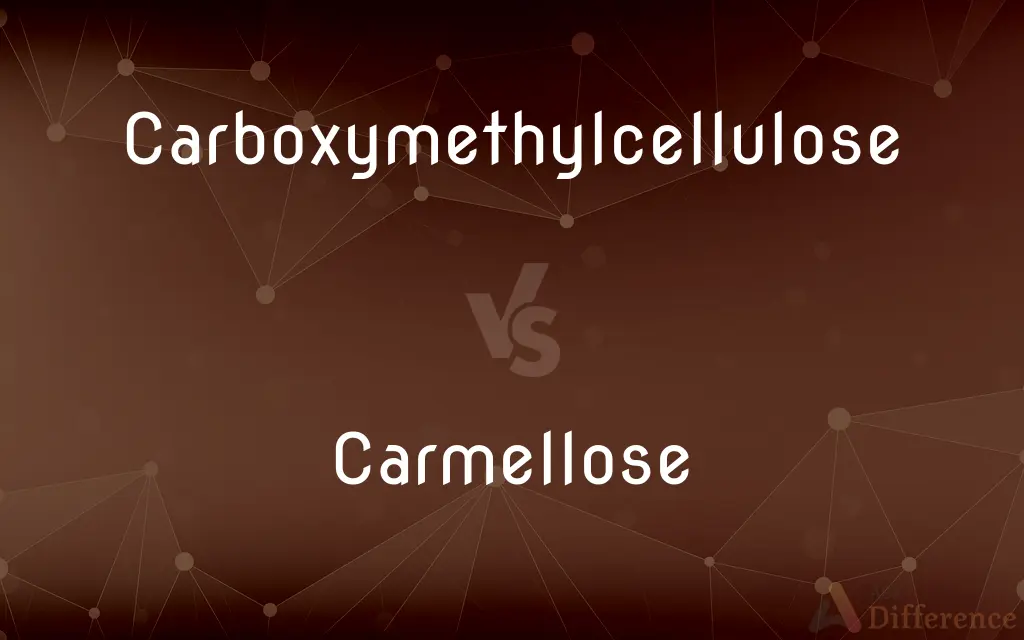Carboxymethylcellulose vs. Carmellose — What's the Difference?
Edited by Tayyaba Rehman — By Fiza Rafique — Updated on March 28, 2024
Carboxymethylcellulose and carmellose refer to the same compound, a derivative of cellulose used as a thickener, stabilizer, and to improve texture in various products.

Difference Between Carboxymethylcellulose and Carmellose
Table of Contents
ADVERTISEMENT
Key Differences
Carboxymethylcellulose (CMC), often known simply as carmellose, is a chemically modified derivative of cellulose, which is the most abundant organic polymer on Earth. Both terms describe the same substance, which is utilized extensively in the food industry, pharmaceuticals, and cosmetics for its ability to thicken, stabilize emulsions, and retain moisture.
The difference in naming arises from the context of use and regional preferences. "Carboxymethylcellulose" is the more chemically descriptive term, highlighting its cellulose backbone modified with carboxymethyl groups. "Carmellose," on the other hand, is a shorter and more convenient term that is often used in pharmaceutical contexts.
Despite the difference in nomenclature, both terms point to the same versatile and valuable properties of CMC. It is prized for its non-toxicity, biocompatibility, and ability to form highly viscous solutions at low concentrations. Additionally, it is often used as a lubricant in eye drops and as a stabilizer in foods to improve texture and shelf life.
The manufacturing process for carboxymethylcellulose involves treating cellulose with sodium hydroxide and chloroacetic acid, resulting in the carboxymethylation of cellulose. This process enhances the solubility of cellulose in water, making it useful in a wide range of applications where water solubility and viscosity modification are desired.
Regardless of the term used, the substance plays a crucial role in various industries, offering functional benefits that enhance product performance and consumer experience. The choice between "carboxymethylcellulose" and "carmellose" often depends on industry standards, regulatory requirements, and marketing considerations.
ADVERTISEMENT
Comparison Chart
Description
A sodium salt derivative of cellulose modified with carboxymethyl groups.
An alternative name for carboxymethylcellulose, emphasizing its use in pharmaceuticals.
Uses
Thickening agent, stabilizer, moisture retainer in food, pharmaceuticals, and cosmetics.
Same as carboxymethylcellulose, with a focus on pharmaceutical applications.
Naming Reason
Chemically descriptive, highlighting its modification.
Shorter, convenient term often used in pharmaceutical contexts.
Solubility
Water-soluble, forming highly viscous solutions.
Same as carboxymethylcellulose.
Properties
Non-toxic, biocompatible, effective at low concentrations.
Identical properties to carboxymethylcellulose.
Compare with Definitions
Carboxymethylcellulose
A water-soluble thickener used in foods.
CMC is added to ice cream to improve its texture.
Carmellose
Another name for CMC in eye drop formulations.
Carmellose serves as a lubricant in dry eye treatments.
Carboxymethylcellulose
A stabilizer in pharmaceuticals.
Carboxymethylcellulose is used in eye drops for lubrication.
Carmellose
Used in oral pharmaceuticals as a disintegrant.
Carmellose helps tablets dissolve quickly in the mouth.
Carboxymethylcellulose
A moisture retainer in cosmetics.
CMC extends the shelf life of facial creams by retaining moisture.
Carmellose
A component in cosmetic creams.
In cosmetics, carmellose helps maintain skin hydration.
Carboxymethylcellulose
A non-toxic, biodegradable substance.
CMC's biocompatibility makes it safe for use in edible products.
Carmellose
Utilized in the production of water-based paints.
Carmellose improves the spreadability of paint.
Carboxymethylcellulose
A viscosity modifier in industrial applications.
Carboxymethylcellulose is used in drilling fluids to control viscosity.
Carmellose
Found in food products as a thickener.
Carmellose is added to sauces to enhance their consistency.
Carboxymethylcellulose
A derivative of cellulose whose sodium salt is used in the manufacture of processed foods as a stabilizing and emulsifying agent, in drugs to add viscosity and lubrication, and in sizing paper and textiles.
Carmellose
Carboxymethyl cellulose
Carboxymethylcellulose
(organic chemistry) The product of the reaction of cellulose with chloroacetic acid; it is used as a thickener and to stabilize emulsions
Common Curiosities
Is carboxymethylcellulose safe for consumption?
Yes, it is considered non-toxic and is widely used in food and pharmaceutical products.
Why is carboxymethylcellulose added to food?
It acts as a thickener, stabilizer, and moisture retainer, improving texture and shelf life.
How does carboxymethylcellulose affect the texture of products?
It can significantly enhance the viscosity and texture, making products creamier or thicker.
Can carboxymethylcellulose cause allergies?
It is generally considered safe, but as with any compound, some individuals may experience sensitivities.
Are carboxymethylcellulose and carmellose different?
No, they refer to the same chemical compound but are used interchangeably based on context.
Is carboxymethylcellulose environmentally friendly?
Being biodegradable and derived from renewable resources, CMC is considered environmentally friendly.
Why is carboxymethylcellulose preferred in eye drops?
Its lubricating properties and biocompatibility make it ideal for relieving dry eye symptoms.
Is there a natural source of carboxymethylcellulose?
It is derived from natural cellulose, which is chemically modified to produce CMC.
Can carboxymethylcellulose be used in vegan products?
Yes, as a cellulose derivative, it is plant-based and suitable for vegan formulations.
Can carmellose be used in all types of pharmaceuticals?
Yes, it is versatile and can be used in various formulations, including tablets, eye drops, and lotions.
How does carmellose improve cosmetic products?
It helps retain moisture, improving the product's feel and extending its shelf life.
How does carmellose help in tablet disintegration?
It facilitates water absorption, causing tablets to swell and disintegrate quickly for faster action.
What makes carboxymethylcellulose soluble in water?
The chemical modification of cellulose introduces carboxymethyl groups, enhancing its water solubility.
Can carboxymethylcellulose be used in gluten-free products?
Yes, it is gluten-free and can be used as a substitute for gluten in various food products.
Are there any restrictions on using carboxymethylcellulose in organic products?
Regulations vary by region, but CMC can often be used in organic products within certain limits.
Share Your Discovery

Previous Comparison
Plenty vs. Abundance
Next Comparison
Vacation vs. VacancyAuthor Spotlight
Written by
Fiza RafiqueFiza Rafique is a skilled content writer at AskDifference.com, where she meticulously refines and enhances written pieces. Drawing from her vast editorial expertise, Fiza ensures clarity, accuracy, and precision in every article. Passionate about language, she continually seeks to elevate the quality of content for readers worldwide.
Edited by
Tayyaba RehmanTayyaba Rehman is a distinguished writer, currently serving as a primary contributor to askdifference.com. As a researcher in semantics and etymology, Tayyaba's passion for the complexity of languages and their distinctions has found a perfect home on the platform. Tayyaba delves into the intricacies of language, distinguishing between commonly confused words and phrases, thereby providing clarity for readers worldwide.















































